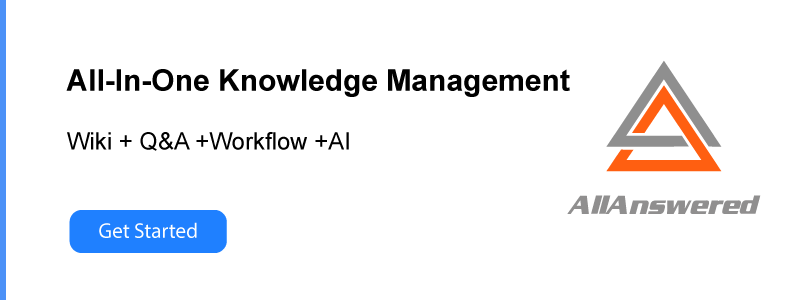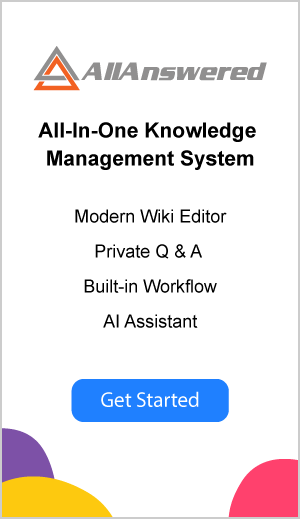Drive Revenue by Empowering Your Sales Team to Have Better Conversations
Client-facing teams with access to subject matter expertise and ongoing knowledge are empowered to have valuable conversations, and it's these conversations that boost sales effectiveness and drive revenue. Today, more than ever, sales are conversation-driven, so when prospects are engaged in real-time conversation, those conversations need to be moving forward and adding value all the way.
About Sales Enablement
Sales enablement is an ongoing and strategic process that ensures all client-facing employees are able to engage in valuable conversations consistently and systematically with customers. Today, during both the pre-and post-sales journey, customers expect to receive the same level of knowledge and service from anyone they interact with. They're not fussed about that person's title, whether they work with pre-or post-sales, all they're asking for is the same level of expertise and service.
Sales Enablement Ensures Sellers Have Better Conversations
Sales enablement could be described as a marketing function for salespeople - it's a method of giving salespeople assets of information they can use during phone conversations.
There's a great sales enablement team behind every great sales team, with the enablement team providing both support and real-time sales documentation needed for effective conversations.
At many successful companies, the enablement team uses up-to-date knowledge as a way of empowering the customer-facing teams to have better and more effective conversations with both prospects and customers. Companies use a knowledge-first approach to keep the introductory sales slide decks and the accompanying sales documentation up-to-date.
Why Sales Scripts and Other Documentation Doesn't Work
In the past, sales documentation for slide decks has typically been in the form of sales scripts. Scripts were written out by an enablement team for representatives to memorize, with the emphasis on the narrative as described in the deck. Unfortunately, when anyone memorizes a script, the result can be a robotic conversation. The last thing you need is for your representatives to sound robotic or panic when they're led off track by a prospect.
Sales documentation fails when the deck itself is too narrow. When a slide features customer stories or specific statistics, the sales representative will automatically steer the conversation towards those talking points; however, if the prospect on the phone doesn't connect to that specific customer story, the pitch will feel all wrong. Even worse, reps can be tuned out altogether by prospects when there's text overload. The deck is not designed to be center stage – it's only a prop.
Sales Documentation Must Be Flexible
The intro slide decks should be short, 5 slides or so, which sets the scene for our reps to tell unique stories specifically designed to individual prospects. We also ensure that the sales documentation accompanying the slides is not too rigid - we only offer suggestions with some included talking points. This gives our reps freedom to tell their own stories instead of repeating the same stories over and over on every discovery call.
The lack of detailed, written scripts does not mean our reps are left hanging in terms of sales documentation. A template is created to coincide with every slide, and this template provides the applicable knowledge required by reps to guide them in their conversations.
The Best Approach To Sales Documentation
At AllAnswered, we provide our reps with the necessary content to back up each individual slide. This additional information, together with the slide, gives the reps everything they need to use when presenting.
You may be wondering why the talking points are not simply added to the notes section at the bottom of the deck. The reason is that, for customization purposes, reps are asked to make a copy of the master slide deck, and once that's done, whatever's written in the notes section becomes inactive. If a talking point has been updated in the master deck's notes, any rep who had already copied the last version would not realize that changes had been made.
The notes section only contains a link to the sales documentation, which is reviewed and kept updated. Because of our verification workflow, our reps trust that the information is accurate because they can see the latest updates.
Creating A Flexible Sales Documentation Blueprint
No. 1: Practice Makes Perfect
Combining knowledge with slides creates the ideal format so the sales reps felt empowered to have quality conversations on live prospect calls. Things that you should consider –
- The amount of information to be included in each section;
- Which knowledge should be included, and how it could be ordered for easy usage; and
- How to ensure the overall flow was well received by both internal reps and prospects.
No. 2: Provide Reps with Content Options
The main challenge of the process was determining just how much content should be included. The amount of additional information should be kept small, clear, and easy to grasp. While the representatives are on the phone with customers, we don't want to provide too much information.
Also, consider including customer stories in your documentation. It gives the reps the ability to decide which customer story will be most relevant to their prospect. In addition, links are included to more background content if reps should require additional information.
No. 3: Ask for Feedback from Sales Reps and Prospects
The formatting and content decisions should be determined by feedback from both your sales reps and prospects. The reps are encouraged to provide honest feedback, especially on how well the narrative flowed in real conversations.
Once the sales documentation are rolled out, you should review how the content is being used by your sales reps on a regular basis. Based on how reps follow the questions, talking points, and stats, adjust and update the documentation accordingly.
Sales Team Are Empowered with Real-Time Knowledge
Every prospect has a unique problem, and every rep is an individual with their own unique way of telling a story. The best practice is providing reps with relaxed guidelines to use when conversing with prospects, along with documentation that has been validated.
Both the product marketing and sales enablement teams gain valuable insights by updating sales documentation with a knowledge-first approach. Simultaneously, the sales team remains confident because they're not required to memorize lines; they know that all that's required of them is to simply have a conversation with prospects.








